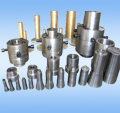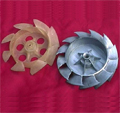

| Address: | PDS Enterprise Inc. 1650 West Artesia Blvd, Suite 278 Gardena, CA90248 |
| Phone: | 1-843-408-0142 |
| Email: | pdsenterprise@gmail.com sales@coolprototyping.com |


Home>FAQ
231. What is Rapid Tooling
A much-anticipated application of rapid prototyping is rapid tooling, the automatic fabrication of production quality machine tools. Tooling is one of the slowest and most expensive steps in the manufacturing process, because of the extremely high quality required. Tools often have complex geometries, yet must be dimensionally accurate to within a hundredth of a millimeter. In addition, tools must be hard, wear-resistant, and have very low surface roughness (about 0. 5 micrometers root mean square). To meet these requirements, molds and dies are traditionally made by CNC-machining, electro-discharge machining, or by hand. All are expensive and time consuming, so manufacturers would like to incorporate rapid prototyping techniques to speed the process. Rapid tooling can be divided into two categories, indirect and direct. Indirect Tooling: Most rapid tooling today is indirect: RP parts are used as patterns for making molds and dies.
RP models can be indirectly used in a number of manufacturing processes:Thomas Sabo Bracelets (1)Vacuum Casting: In the simplest and oldest rapid tooling technique, a RP positive pattern is suspended in a vat of liquid silicone or room Temperature vulcanizing (RTV) rubber. When the rubber hardens, it is cut into two halves and the RP pattern is removed. The resulting rubber mold can be used to cast up to 20 polyurethane replicas of the original RP pattern. A more useful variant, known as the Kiloton powder metal sintering process, uses the rubber molds to produce metal tools. (2)Sand Casting: A RP model is used as the positive pattern around which the sand mold is built. LOM models, which resemble the wooden models traditionally used for this purpose, are often used. If sealed and finished, a LOM pattern can produce about 100 sand molds. (3)Investment Casting: Some RP prototypes can be used as investment casting patterns. The pattern must not expand when heated, or it will crack the ceramic shell during autoclaving. Both Strategy's and Cubical make investment casting wax for their machines. Paper LOM prototypes may also be used, as they are dimensionally stable with temperature. (4)First, a stereo lithography machine is used to make a match-plate positive pattern of the desired molding. To form the mold, the SLA pattern is plated with nickel, which is then reinforced with a stiff ceramic material. The two mold halves are separated to remove the pattern, leaving a matched die set that can produce tens of thousands of injection moldings.
Direct Tooling : To directly make hard tooling from CAD data is the Holy Grail of rapid tooling. Realization of this objective is still several years away, but some strong strides are being made. (1)Rapid Tool: A DTM process that selectively sinters polymer- coated steel pellets together to produce a metal mold. The mold is then placed in a furnace where the polymer binder is burned off and the part is infiltrated with copper (as in the Retool process). The resulting mold can produce up to 50,000 injection moldings. (2)Laser-Engineered Net Shaping (LENS) is a process developed at Sandia National Laboratories and Stanford University that can create metal tools from CAD data. Materials include 316 stainless steel, Income 625, H13 tool steel, tungsten, and titanium carbide cermets. A laser beam melts the top layer of the part in areas where material is to be added. Powder metal is injected into the molten pool, which then solidifies. Layer after layer is added until the part is complete. Unlike traditional powder metal processing, LENS produces fully dense parts, since the metal is melted, not merely sintered. The resulting parts have exceptional mechanical properties, but the process currently works only for parts with simple, uniform cross sections. The system has been commercialized by MTS Corporation. Direct AIM (ACES Injection Molding): A technique from 3D Systems in which stereo lithography-produced cores are used with traditional metal molds for injection molding of high and low density polyethylene, polystyrene, polypropylene and ABS plastic. Very good accuracy is achieved for fewer than 200 moldings. Long cycle times (5min) are required to allow the molding to cool enough that it will not stick to the SLA core. In another variation, cores are made from thin SLA shells filled with epoxy and aluminum shot. Aluminum's high conductivity helps the molding cool faster, thus shortening cycle time. The outer surface can also be plated with metal to improve wear resistance. Production runs of 1000-5000 moldings are envisioned to make the process economically viable.Thomas Sabo Necklaces (3) LOM Composite parts would be very strong and durable, and could be used as tooling in a variety of manufacturing processes. (4)Sand Molding: At least two RP techniques can construct sand molds directly from CAD data.DTM sells sand-like material that can be sintered into molds. Solingen uses 3DP to produce ceramic molds and cores for investment casting, (Direct Shell Production Casting).
 We are constantly looking for new products in order to grow our business and Invention Home has enabled us to streamline that process much more quickly.
We are constantly looking for new products in order to grow our business and Invention Home has enabled us to streamline that process much more quickly. Marsha Dunmyre
CA, U.S.A
Cool Prototyping Copyright 2008-2009 © All Rights Reserved. Rapid Prototyping






